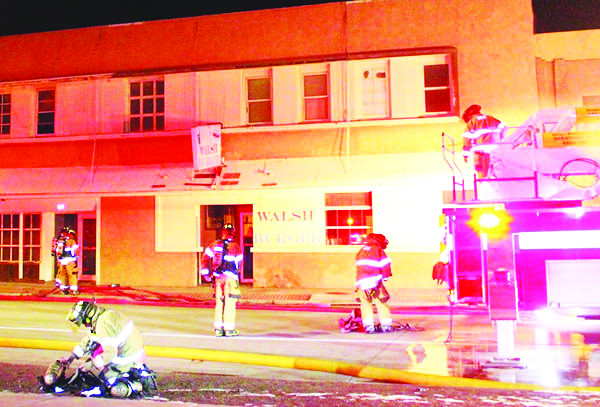City of Alamosa purchases, takes ‘immediate control’ of Walsh Hotel

ALAMOSA — After extensive ongoing negotiations with the Colorado Springs-based property owner, the city of Alamosa has purchased and taken “immediate control” of the Walsh Hotel located at 617 Sixth Street in Alamosa.
Once a landmark hotel, built in 1911 and boasting comfortable apartments, a dining room, cocktail lounge and fountain in the lobby, the boarded-up building has deteriorated into a “dangerous,” burned-out vacant structure that has become the site of numerous trespasses resulting in fire crews being called to the site at least five times in the last two years, with the most recent event taking place last weekend.
Last week, it was announced that the city of Alamosa purchased the building from Rian Lamoreaux, whose investment company owned the property, for the sum of $72,000, $22,000 more than what Lamoreaux paid for the property.
“The property has been a nuisance, especially for squatters, for years,” said City Manager Heather Brooks when asked about the purchase price. “The city was using every available tactic to get the situation taken care of, given that it was private property. Using existing ordinances, the city established the building as dangerous and a nuisance through municipal court, which resulted in the stipulation with a reasonable timeframe for the previous owner to repair the structure.”
That stipulation — which allowed a period of time during which “remediation” of the property had to take place or the city would move forward with plans for demolition — was in place and attached to the property when Lamoreaux purchased the property. In addition to having that information, staff also reached out multiple times to see how they could help and to remind him of the deadline.
Ultimately, the stipulation was enforced when Lamoreaux failed to meet the deadlines.
“It was clear that (he) did not fully appreciate the nuisance that his building was having on the neighborhood or the deadlines that had been set on the property,” Brooks said. “(Lamoreaux) was certainly non-compliant with the requirements he and his predecessor agreed to for mitigation of the nuisance.”
Brooks further explained the value in the city negotiating for ownership versus pursuing other avenues.
“(Buying the property) gave the city control over the property immediately,” she said. “Ownership also allows us to pursue grants for demolition.”
If the city had chosen to demolish the building and place a tax lien on the property for the cost of that demolition, Lamoreaux would have retained ownership after the city had taken care of demolishing the building for him. Since the post-demolition property would never appraise for the amount of the demolition costs, it was anticipated that after three years the city would own the property through the operation of the tax lien for demolition costs.
However, the city would also be out the costs of the demolition, which — before the last fire — was estimated at upwards of $250,000. Spending $72,000 was cheaper than paying the demolition out of pocket and gave the city immediate control over what steps could be taken.
“The city obviously wanted to secure the property at the lowest amount possible, but the larger objective was removing the nuisance…on our own schedule and hopefully with the assistance of Brownfields or other available grants,” Brooks said. “And we couldn’t force the property owner to sell the property at a certain price.
“While it’s uncomfortable to ‘interfere with private property rights, there are times when it’s necessary in order to eliminate nuisances and blight property.”
Brooks says efforts are already in progress to obtain grant funding from multiple sources to demolish the building, but that process takes time. As trespassing continues — especially with below-freezing temperatures every night — staff is working on assessing how trespassers are gaining entry to the building and will evaluate how to better secure the structure.



